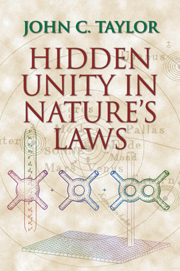Book contents
- Frontmatter
- Contents
- Preface
- 1 Motion on Earth and in the Heavens
- 2 Energy, Heat and Chance
- 3 Electricity and Magnetism
- 4 Light
- 5 Space and Time
- 6 Least Action
- 7 Gravitation and Curved Spacetime
- 8 The Quantum Revolution
- 9 Quantum Theory with Special Relativity
- 10 Order Breaks Symmetry
- 11 Quarks and What Holds Them Together
- 12 Unifying Weak Forces with QED
- 13 Gravitation Plus Quantum Theory – Stars and Black Holes
- 14 Particles, Symmetries and the Universe
- 15 Queries
- APPENDIX A The Inverse-Square Law
- APPENDIX B Vectors and Complex Numbers
- APPENDIX C Brownian Motion
- APPENDIX D Units
- Glossary
- Bibliography
- Index
1 - Motion on Earth and in the Heavens
Published online by Cambridge University Press: 20 January 2010
- Frontmatter
- Contents
- Preface
- 1 Motion on Earth and in the Heavens
- 2 Energy, Heat and Chance
- 3 Electricity and Magnetism
- 4 Light
- 5 Space and Time
- 6 Least Action
- 7 Gravitation and Curved Spacetime
- 8 The Quantum Revolution
- 9 Quantum Theory with Special Relativity
- 10 Order Breaks Symmetry
- 11 Quarks and What Holds Them Together
- 12 Unifying Weak Forces with QED
- 13 Gravitation Plus Quantum Theory – Stars and Black Holes
- 14 Particles, Symmetries and the Universe
- 15 Queries
- APPENDIX A The Inverse-Square Law
- APPENDIX B Vectors and Complex Numbers
- APPENDIX C Brownian Motion
- APPENDIX D Units
- Glossary
- Bibliography
- Index
Summary
How modern science began when people realized that the same laws of motion applied to the planets as to objects on Earth.
Galileo's Telescope
In the summer of 1609, Galileo Galilei, professor of mathematics at the University of Padua, began constructing telescopes and using them to look at the Moon and stars. By January the next year he had seen that the Moon is not smooth, that there are far more stars than are visible to the naked eye, that the Milky Way is made of a myriad stars and that the planet Jupiter has faint “Jovian planets” (satellites) revolving about it. Galileo forthwith brought out a short book, The Starry Messenger (the Latin title was Sidereus Nuncius), to describe his discoveries, which quickly became famous. The English ambassador to the Venetian Republic reported (I quote from Nicolson's Science and Imagination):
I send herewith unto his Majesty the strangeth piece of news …; which is the annexed book of the Mathematical Professor at Padua, who by the help of an optical instrument (which both enlargeth and approximateth the object) invented first in Flanders, and bettered by himself, hath discovered four new planets rolling around the sphere of Jupiter, besides many other unknown fixed stars; likewise the true cause of the Via Lactae, so long searched; and, lastly, that the Moon is not spherical but endued with many prominences. … So as upon the whole subject he hath overthrown all former astronomy … and next all astrology. … And he runneth a fortune to be either exceeding famous or exceeding ridiculous. […]
- Type
- Chapter
- Information
- Hidden Unity in Nature's Laws , pp. 1 - 31Publisher: Cambridge University PressPrint publication year: 2001



